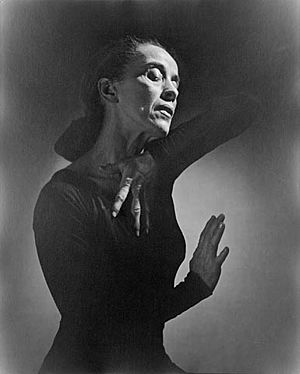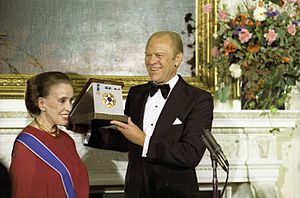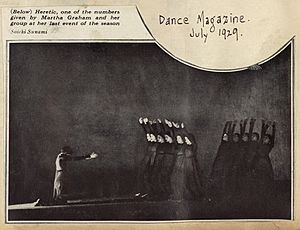Martha Graham facts for kids
Quick facts for kids
Martha Graham
|
|
|---|---|

Graham image by Yousuf Karsh, 1948
|
|
| Born | May 11, 1894 Allegheny (later Pittsburgh), Pennsylvania, U.S.
|
| Died | April 1, 1991 (aged 96) New York City, U.S.
|
| Known for | Dance and choreography |
| Movement | Modern dance |
| Spouse(s) |
Erick Hawkins
(m. 1948–1954) |
| Awards | Kennedy Center Honors (1979) Presidential Medal of Freedom (1976) National Medal of Arts (1985) |
Martha Graham (born May 11, 1894 – died April 1, 1991) was a famous American modern dancer and choreographer. She created a unique dance style called the Graham technique. This style completely changed American dance and is still taught all over the world today.
Martha Graham danced and taught for more than 70 years. She was the first dancer to perform at the White House. She also traveled to other countries as a cultural ambassador. Graham received the highest award for a civilian in the US, the Presidential Medal of Freedom with Distinction. She once said that dance allowed life to use her "in an intense way." The Martha Graham School, which she started in 1926, is the oldest dance school in the United States. It began in a small studio in Carnegie Hall and now has two studios in New York City.
Contents
Early Life and Dance Beginnings
Martha Graham was born in Allegheny City, which is now part of Pittsburgh, Pennsylvania, in 1894. Her father, George Graham, was a doctor who practiced an early form of psychiatry. Her parents were strict Presbyterians and did not encourage dancing at home.
When Martha was 14, her family moved to Santa Barbara, California. In 1911, she saw her first dance show. It was a performance by Ruth St. Denis in Los Angeles. In the mid-1910s, Martha Graham started studying at the Denishawn School of Dancing and Related Arts. This school was founded by Ruth St. Denis and Ted Shawn. Graham stayed there until 1923.
A New Way to Dance
When Martha Graham left the Denishawn school in 1923, she wanted dance to be more about real human feelings. She felt dance should not just be for entertainment. This led her to remove the fancy movements of ballet and her Denishawn training. Instead, she focused on the basic ways the human body moves.
In 1925, Graham worked at the Eastman School of Music. There, she and Rouben Mamoulian made a short film called The Flute of Krishna. It showed Eastman students dancing. Graham left Eastman shortly after Mamoulian did.
In 1926, the Martha Graham Center of Contemporary Dance was created. It was in a small studio in New York City. On April 18, 1926, Graham performed her first independent concert. It had 18 short dances she had created herself. She later said that everything she did was still influenced by her time at Denishawn. Around this time, she also worked with photographer Soichi Sunami. Together, they created many famous images of early modern dance.
One of Graham's students was Bethsabée de Rothschild. They became good friends. When Rothschild started the Batsheva Dance Company in Israel in 1965, Graham became its first director.
The Graham Technique: Contraction and Release
Graham's dance style introduced a new idea called "contraction and release." This idea came from how we breathe.
The "contraction and release" technique became very famous. It helped Graham show deeper human emotions through movement. Depending on how the head was placed, each movement could show positive or negative feelings. This technique made Graham's style feel heavy and connected to the ground. This was very different from classical ballet, which often tries to look weightless. To balance the sharp, sudden movements, Graham later added a "spiral" shape to her technique. This brought a sense of flowing motion.
Bringing Stories to the Stage
After her first concert, Graham created Heretic (1929). This was her first group dance that clearly showed a new direction away from her Denishawn training. It gave a hint of the powerful work she would create later. The dance used tight, sharp movements. The dancers wore simple clothes. The piece was about being rejected, a theme Graham would use again in her other works.
Over time, Graham started using more detailed sets and scenery in her dances. She often worked with Isamu Noguchi, a Japanese American designer. His ideas for sets perfectly matched Graham's choreography.
Graham often explored two main themes in her work: American life and Greek mythology. One of her most famous dances about American life is Appalachian Spring (1944). She worked with composer Aaron Copland, who won a Pulitzer Prize for the music. Noguchi created the simple set. Graham often danced in her own pieces. In Appalachian Spring, she played the bride of a new couple. Their hopeful new life was balanced by a strong pioneer woman and a preacher.
Two of Graham's dances, Cave of Heart (1946) and Night Journey (1947), showed her interest in Greek mythology. They also explored the feelings of women. Both pieces retold Greek myths from a woman's point of view.
In 1936, Graham created Chronicle. This dance brought serious issues to the stage in a dramatic way. It was influenced by the Wall Street Crash of 1929, the Great Depression, and the Spanish Civil War. The dance focused on feelings of sadness and being alone. This was shown through the dark sets and costumes.
In 1936, the German government wanted to include dance in the Olympic Art Competitions. Even though the German government didn't like modern dance, they invited Graham to represent the United States. However, Graham refused the invitation. She did not want to support a government that was against certain groups of people.
Inspired by the 1936 Olympics and the messages she heard from the Axis Powers, Martha Graham created American Document in 1938. This dance showed American ideals and democracy. Graham believed dance could inspire people to fight against unfair ideas. American Document became a patriotic statement. It focused on rights and injustices of the time. It represented all American people, including Native-American heritage and the history of slavery. During the show, parts of The Declaration of Independence, Lincoln's Gettysburg Address, and the Emancipation Proclamation were read aloud. These parts highlighted American ideals. Graham believed a dance needed to "reveal certain national characteristics" to be meaningful.
This dance also brought together dance, theater, and literature in new ways. It clearly defined the roles of the audience and the performers. This made Graham a key figure in the modern dance revolution.
1938 was a big year for Graham. The Roosevelt family invited her to dance at the White House. This made her the first dancer to perform there. Also in 1938, Erick Hawkins became the first man to dance with her company. He joined her group the next year and danced lead male roles. They married in 1948 but divorced in 1954.
On April 1, 1958, the Martha Graham Dance Company performed the ballet Clytemnestra. It was based on an ancient Greek legend and was a huge success. This was the only full-length work in Graham's career. Graham choreographed and danced the main role. The ballet told the story of Queen Clytemnestra. She kills her husband, King Agamemnon, to get revenge for him sacrificing their daughter. Clytemnestra is then killed by her son. The audience sees Clytemnestra in the afterlife. This ballet is considered a masterpiece of 20th-century American modernism.
Graham worked with many composers, including Aaron Copland for Appalachian Spring, Louis Horst, Samuel Barber, and William Schuman. Her long-time friend and music partner, Louis Horst, died in 1964. She said he gave her "a landscape to move in."
Graham did not like her dances to be recorded. She believed live performances should only exist on stage. However, there were a few exceptions. She worked with photographers like Soichi Sunami, Imogen Cunningham, and Barbara Morgan. She thought Philippe Halsman's photos of Dark Meadow were the best record of any of her dances. Later, her ideas changed, and others convinced her to allow some of her work to be recorded. In 1952, Graham allowed her meeting with the famous deafblind author Helen Keller to be taped. Keller became a close friend and supporter. Graham was inspired by Keller's joy from dance, as Keller felt the vibrations of drums and movement.
Martha Graham's last performance was in 1970, when she was 76 years old, in a piece called Cortege of Eagles. She created 181 dance compositions in her career.
Later Years and Legacy
After she stopped performing on stage, Graham went through a difficult time. However, she recovered. In 1972, she returned to her studio, reorganized her company, and created ten new ballets. Her last completed ballet was Maple Leaf Rag in 1990.
Martha Graham continued to choreograph until she died from pneumonia in New York City in 1991, at age 96. Just before she became sick, she finished her autobiography, Blood Memory, which was published after her death. Her ashes were spread over the Sangre de Cristo Mountains in New Mexico.
Influence and Awards
Martha Graham is sometimes called the "Picasso of Dance." This means her importance to modern dance is like what Pablo Picasso was to modern art. Her influence has also been compared to Stravinsky in music and Frank Lloyd Wright in architecture.
In 2013, her dance films were chosen to be saved in the National Film Registry by The Library of Congress. This shows how important her work is.
To celebrate her 117th birthday on May 11, 2011, Google changed its logo for a day to honor Graham's life and legacy.
Graham is known for bringing dance into the 20th century. Thanks to her assistants, much of her work and technique have been saved. They recorded interviews with Graham describing her technique and videos of her performances. She created a whole new movement that changed the dance world forever. Now, dancers all over the world study and perform modern dance. Choreographers and professional dancers still look to her for inspiration.
In 2021, actress Mary Beth Peil played Martha Graham in the Netflix series Halston.

In 1957, Graham was chosen as a Fellow of the American Academy of Arts and Sciences. President Gerald Ford awarded her the Presidential Medal of Freedom in 1976. President Ford called her "a national treasure."
Graham received the first American Dance Festival award for her lifetime achievements in 1981. In 1984, she was given France's highest honor, the Legion of Honour. In 1987, Graham was added to the National Museum of Dance's Hall of Fame.
In 1998, Time magazine named Graham "Dancer of the Century." People magazine called her one of the female "Icons of the Century." In 2015, she was added to the National Women's Hall of Fame.
On May 11, 2020, the New York Public Library for the Performing Arts announced it had received Graham's archives. These archives include papers, photos, and rare films of Graham dancing.
Martha Graham Dance Company
The Martha Graham Dance Company is the oldest dance company in America. It was founded in 1926. Many famous dancers and choreographers of the 20th and 21st centuries have been part of this company. These include Erick Hawkins, Merce Cunningham, and Paul Taylor. The company continues to perform today.
Early Dancers
Some of Graham's first female dancers included Bessie Schonberg, Anna Sokolow, Sophie Maslow, and Pearl Lang. Later female dancers included Yuriko and Mary Hinkson. The male dancers included Erick Hawkins, Merce Cunningham, Paul Taylor, and Bertram Ross.
Images for kids
-
President Gerald Ford awarding the Presidential Medal of Freedom with Distinction to Martha Graham, 1976.
See also
 In Spanish: Martha Graham para niños
In Spanish: Martha Graham para niños






